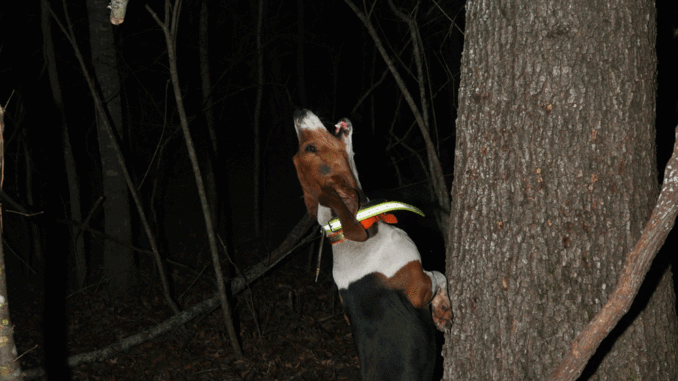
Learn more about guns, dogs and other equipment raccoon hunters take into the woods at night.
The meeting took place at a travel center in Rocky Point, located just off I-40 at the NC 210 exit. Pickups parked side by side, David MacCallum, Vernon Eakins and Mike Milam walked to the counter in hip booats to buy snacks and soft drinks.
Wearing a white helmet with a headlamp, MacCallum looked like a coal miner, but the black footprints of a raccoon stenciled on his hard hat told a different story. Darkness had fallen a few minutes earlie, and it was time to hunt raccoons.
“This is one of our prime gathering spots,” said MacCallum, a 36-year-old landscaper who lives in Rocky Point. “We travel extensively to hunt, but this spot has plenty of parking, so we meet here when we are hunting close to home.”
The members of the Pender County Coon Club finished their preparations and drove a few miles to a piece of private property in Mooretown, near Holly Shelter Game Land.
“You can’t run out of private land to hunt in this area,” he said. “Once deer season ends, the deer hunters want us to help them out by reducing the number of coons that eat the corn they put out for deer, but they don’t like having their deer disturbed at night during the deer season.”
Eakins, a 63-year-old retiree from Castle Hayne said his group was plenty friendly with turkey hunters, too.
“The turkey hunters really seek us out,” Eakins said. “They don’t want the coons eating the eggs of the turkeys in the nest come spring.”
MacCallum and Eakins are veteran raccoon hunters with many miles and many years under their battery-toting belts; Milam is just starting to train Chief, his 19-month-old bluetick hound.
“I hunt deer and turkeys,” said Milam, 32, who owns a hardware store in Burgaw. “But due to my long work hours, I don’t get to hunt them as much as I want. With coon hunting, I can go out after I get off work almost any evening. It’s easy to get hooked on it, once you hear the dogs trailing in the black of night. You never know what you’re going to see up the tree until you shine the light. It’s the anticipation of spotting a coon up there that keeps you coming back for more.
The caravan turned onto a gravel road, then onto a rain-slick trail before they parked and dropped tailgates. MacCallum fitted his Walker hound, Queen, with a GPS tracking collar, then led her on a leash along the road to try to find a hot track.
“We hunt coons five or six days each week,” he said. “After I get off work, I still have time to go hunting, and my family is very understanding.”
Queen, whose registered name is David’s Stylish Queen, is a United Kennel Club Nite Champion — a title that puts the 6-year-old dog in the top rank of treeing dogs. Eakins’ 2-year-old Walker, is Walnut Branch Mountain Taylor — Taylor for short. Taylor stayed in the truck for the first cast, a common practice, according to Eakins.
“We prefer running dogs by themselves, except when they’re young,” Eakins said. “We turn an inexperienced dog out with an older dog until they learn what to do.”
Milam fitted a collar on Chief. Once Queen’s wagging tail showed she had scented something of interest, Chief splashing across a ditch and into the dense cypress and gum swamp after her.
It wasn’t long before Queen struck trail. Chief only barked a few times before returning to his owner. While MacCallum said he wasn’t interested in his dogs having titles, his young son, David MacCallum III, said Queen is so good at trailing and treeing that she should be entered in competition.
In field trials, dogs are awarded points for striking a trail and barking at the tree. However, points can also be deducted from the final score if a raccoon is not in the tree when hunters arrive. A raccoon can “tap” a tree then jump away or climb up one tree and cross the limbs to climb down another. It takes a savvy dog to circle a tree to determine if a raccoon is really aloft before barking “treed.”
“It takes one win and two finishes of at least third place for a coon dog to receive a Nite Champion title,” MacCallum said. “Queen did it in only four trials, with two first-place finishes and a third.”
The scent warmed and Queen barked as though she was treeing, but then she began moving swiftly away. Eventually, her closely spaced barks showed she had treed the raccoon. The hunters drove muddy woods trails to get closer. A GPS tracking collar receiver showed where Queen was located and that she had trailed the raccoon 2.9 miles.
“There’s a difference between a coon hound and a coon dog,” Eakins said. “When you hunt with a coon dog, it means you’re hunting with a dog that gives you a reliable chance of seeing a coon. But a coon hound is just a breed of dogs used to hunt coons. Queen is what we call a coon dog.”
After wading three canals and picking their way through vines and briars in the swamp forest, the hunters arrived at the tree where Queen had barked herself nearly to exhaustion. MacCallum shot the raccoon with Remington 597 semi-automatic .22 rifle and allowed Queen a nibble and a sniff of the dead animal as her reward before the hunters returned to their pickups.
Eakins then turned out Taylor. After a few moments, she began barking, but it took her some time to unravel the scent trail. Forty-five minutes later, she was barking up the right tree; the hunters arrived, spotted the raccoon in their lights, then shot it with the rifle.
“We don’t shoot very many coons,” Eakins said, “but we occasionally shoot one for training purposes, and we shoot them if landowner wants to control them. Here, we know there are plenty of coons, so shooting a few helps out the landowner and allows us to give our dogs some great experience. We give the coons we shoot to people who like eating them, and there is always more demand for coon meat than we can meet.”
Eakins said raccoons are delicious when properly prepared — parboiling tenderizes the meat. He stews them until the meat comes off the bone, then he adds onions, potatoes and sage for seasoning. He calls the resulting dish “coon hash.”
Eakins said he had hunted raccoons when he was younger, but work and family obligations had overshadowed his interest in the sport for many years. Once he retired, however, he realized he needed to get more exercise. To get back into good physical condition, he chose to hunt raccoons again.
“Sometimes you might have to walk miles to get to a tree or recover a hound,” he said. “If the ground is soggy and the thickets are dense and you have to get through all of that to get to the tree, you will get more exercise than you can with almost any other outdoor sport. You can’t get that kind of workout at a gym.”
Taylor was cast again, and Milam released Chief, so he could gain the experience of hunting with a more experienced hound. While he followed Taylor into the woods for a good distance, he eventually made his way back to his owner’s side.
“He’s as new to the sport of coon hunting as I am,” Milam said. “But I will learn from David and Vernon, and he will learn from Queen and Taylor. Just look at how well Queen has done because David hunts her nearly every day. All it takes is experience and I love coon hunting. Chief and I are going coon hunting every time we get the chance.
DESTINATION INFORMATION
HOW TO GET THERE: The Holly Shelter Game Land in Bladen County is one of a handful of public-hunting areas in the central and southern coastal plain that holds exceptional numbers of raccoons. Others include: Bladen Lakes, Croatan, Green Swamp and Juniper Creek. See the N.C. Wildlife Resources Commission’s website (www.ncwildlife.org) for locations and maps,
WHEN TO GO: Raccoon season began Oct. 15, 2012, at sunrise and ends on Feb. 28, 2013. The daily bag limit is three; there is no possession limit or season limit. Raccoon hides can be sold because the animal is a furbearer. Axes and saws may not be carried while hunting raccoons.
BEST TECHNIQUES: Hunters usually wait until an hour or so after dark before casting their hounds because it gives the raccoons time to move around and create scent trails. Some hunters hang plastic buckets with PVC spouts in their bases low to the ground to feed raccoons so their scent is easy to locate.
GUNS/EQUIPMENT: MacCallum Loaded with long-rifle, hollow-point ammo, a .22 rimfire such as the Remington 597 semi-automatic is deadly on raccoons. Don’t scrimp on the scope; the better light-gathering capacity of a higher-quality scope makes it a better choice than smaller-diameter, less-expensive scopes. Raccoons are large animals that present danger to hounds if not killed outright while in the tree. Therefore, hunters try to get the raccoon to look down so its eyes are illuminated then shoot the animal between the eyes.

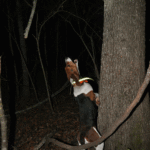
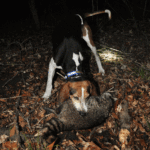
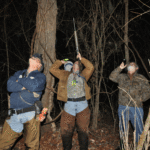
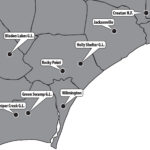




Be the first to comment